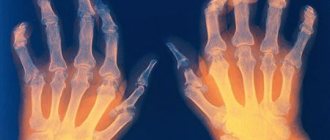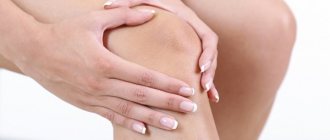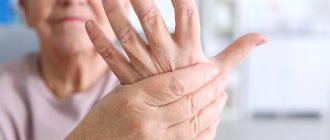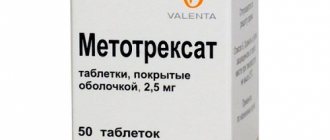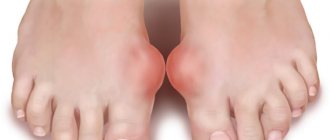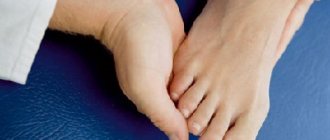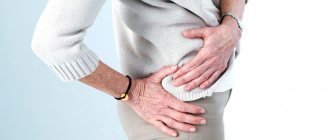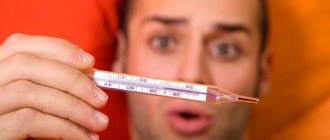Reactive arthritis in children
Non-purulent reactive arthritis is one of the most common rheumatic diseases among children and adolescents, especially males. According to epidemiological studies, 1 child out of 1000 suffers from ReA, and of the total number of patients with rheumatic symptoms, 56% suffer from this disease. Therefore, every parent should learn the causes, symptoms and treatment of reactive arthritis in children in a timely manner.
Causes of reactive arthritis in children
In 4 out of 5 cases, reactive arthritis in children develops from chlamydial infection. Infection is possible through household contact with patients and carriers of infections - people, pets, birds, as well as through airborne droplets, contact and airborne dust. Often, chlamydial infection is congenital - a child becomes infected while passing through the birth canal of a sick mother, in whom the disease can be completely asymptomatic.
Reactive arthritis caused by intestinal infections is especially common among children aged 1-3 years. It occurs as a result of yersiniosis, salmonellosis, shigellosis and campylobacteriosis - a child can get all these diseases when he crawls, puts unwashed hands and toys into his mouth. Arthritis due to nasopharyngeal infection has no age preference, but is relatively rare.
Symptoms of reactive arthritis in children
As a rule, there are no symptoms of a previous infection at the time of detection of ReA. Urogenital infections (such as chlamydia) may not manifest themselves at all in about 40% of cases. For this reason, the following symptoms are significant in children:
- subfebrile body temperature from 37.1 to 38°C;
- fever;
- decreased appetite;
- general weakness and fatigue;
- sudden onset of pain in the joints, which is accompanied by swelling;
- pain in the buttocks, lower back, feet;
- conjunctivitis and other lesions of the eyes and mucous membranes;
- rash in the affected joints;
- the child complains of pain in the fingers, limps, tries to stroke or protect the sore joints.
2-6 weeks before the onset of rheumatic symptoms, you may experience:
- difficulty urinating;
- symptoms of vulvitis, balanitis;
- itching and burning in the perineal area;
- anxiety;
- diarrhea.
The already mentioned Reiter's syndrome can be observed in children for several months, and if left untreated, it can develop into juvenile rheumatoid arthritis.
Treatment of reactive arthritis in children
The selection of treatment for a child begins after collecting a family history and conducting laboratory diagnostics (mainly clinical analysis and biochemical blood tests). The basis of therapy is broad-spectrum antibiotics, which can be prescribed even before identification of the infectious agent (1-2 courses with a break of 5-7 days). For postenterocolitic arthritis, antibiotics may not be prescribed. Also, treatment of reactive arthritis in children includes symptomatic treatment of joint syndrome - pain relief, relief of inflammation, improvement of fluid outflow from adjacent tissues, restoration of mobility in the joint, correction of immune reactions. For this purpose, both general and local therapy (intra-articular injections of glucocorticosteroids), the use of anti-inflammatory ointments, creams and gels are used. Clinical recommendations for reactive arthritis in children and the drugs of choice are determined taking into account age, causative agent of the disease, severity of the disease and individual effectiveness
It is important to keep the room clean, regularly ventilate living rooms, and teach the child the rules of personal hygiene.
Don't get sick and take care of your loved ones!
You might be interested in:
No ballet: arthrosis of the toesOsteoarthrosis of the ankle jointHead spinning: how to deal with osteochondrosis of the cervical regionOsteoarthrosis of the elbow jointArthrosis of the fingers - a disease of musicians or not?
Causes and mechanisms
The term reactive arthritis suggests that the inflammatory process, although associated with an infectious factor, occurs without its presence in the joint, i.e., under “sterile” conditions. The primary cause of the disease is pathogenic bacteria found in other body systems: the genitourinary tract and intestines. Reactive joint process can develop with the following infections:
- Chlamydia.
- Yersiniosis.
- Shigellosis (dysentery).
- Salmonellosis.
There is a clear connection between an external provoking factor (bacterial agent) and the development of inflammatory changes in the joints, which makes it possible to establish the origin of arthritis. According to statistics, it develops much more often in young men than in women. In addition, an extremely important role in the onset of the disease is assigned to the genetic factor (carriage of the histocompatibility antigen HLA-B27).
Extra-articular infection initiates immune reactions with the primary involvement of the cellular defense system, aimed at eliminating it. But the resulting antigen-antibody complexes actively penetrate into the synovial cavity, where, together with cytokines and lymphocytes, they provoke and maintain inflammation.
The cause of reactive arthritis is an extra-articular infection. And immune inflammation of the synovial membrane develops secondarily.
How to treat reaction arthritis?
Initially, it is necessary to eliminate the source of infection.
Depending on the form of the disease and its intensity, the doctor selects therapy in a hospital or on an outpatient basis. First of all, it is necessary to treat the infection that provoked autoimmune arthritis. The therapeutic regimen necessarily includes various medications. The conservative method can be combined with folk remedies. Physiotherapeutic procedures help during the recovery period. Chronic reactive arthritis cannot be cured forever. It is necessary to undergo preventive therapy so that the disease does not worsen and complications do not develop.
Types of drugs for conservative treatment
The drug complex and doses of drugs are selected by the doctor. Drugs can be prescribed in the form of tablets, intra-articular injections, ointments, and local gels. To destroy infectious agents, drugs with antimicrobial activity are prescribed and taken for at least 4 weeks. Medicines for symptomatic therapy are also taken. Treatment of reactive arthritis is carried out with the following medications:
- antibiotics - Tetracyclines, Fluoroquinolones, Macrolides;
- NSAIDs - ointments for arthritis "Diclofenac", "Voltaren";
- corticosteroids - Prednisolone, Cortisone in eye drops and ointments;
- immunosuppressants - Methotrexate, Sulfasalazine;
- TNF inhibitors (special drugs for the treatment of autoimmune arthritis) - Etanercept, Inflixibam;
- probiotics - “Bifidumbacterin Forte”, “Bifiform”.
Treatment with folk remedies
Traditional methods of treatment are used as auxiliary therapy.
Treatment with folk remedies will help speed up recovery and improve the patient’s condition. Reactive arthritis can only be treated with medication, and natural remedies can complement traditional therapy. Compresses made from a mixture of black radish and horseradish help relieve inflammation. It is useful to apply an ointment made from the leaves and roots of comfrey, beeswax and vitamin E to the sore joint. For oral administration, a decoction of burdock roots with the herb of tricolor violet, speedwell and wheatgrass rhizome is recommended; infusion of parsley seeds, birch leaves, violet herb and nettle.
Physiotherapeutic procedures
During the period of remission and during the chronic course of urogenic reactive arthritis, physiotherapy will help. First of all, therapeutic exercises are prescribed to develop joints and relieve pain. A set of exercises for daily performance is selected by a physical therapy instructor or physiotherapist. All movements should be performed slowly, and if unpleasant sensations occur, temporarily stop the load, resuming it after a while. Cryotherapy, massage, sinusoidal currents, therapeutic hydrogen sulfide or salt baths, and mud therapy will help overcome reactive oligoarthritis.
What else can you do to help with reactive arthritis?
Nutrition correction is an integral part of treatment.
To treat arthritis of the wrist joint and other joints, use the drug “Dimexide” for compresses, combining it with local anti-inflammatory drugs and “Hydrocortisone”. When excess inflammatory effusion accumulates in the synovial bursa, it is removed using a puncture. The diet for reactive arthritis excludes alcohol, smoked foods, processed foods, and too salty or pickled foods. Nutrition should include a large amount of fruits, vegetables, berries, proteins, calcium, vitamins C, P, A, D, group B. It is useful to drink vegetable and fruit juices. Homeopathy can complement treatment - natural remedies “Ledum”, “Apis”.
Treatment of the disease
If symptoms of reactive arthritis occur in women or men, treatment is prescribed immediately. Physiotherapy is considered effective. The appointment of procedures is carried out after identifying the cause of the disease and the stage of the pathological process.
During the period of exacerbation the following are prescribed:
- Ultraviolet irradiation. Thanks to the influence of ultraviolet waves, the sensitivity of the nerve fiber in the affected area is reduced, thereby subsiding the pain. The course of therapy ranges from 3 to 6 procedures. Ultraviolet irradiation is contraindicated for chronic kidney and liver diseases.
- Electrophoresis. The procedure reduces the need to use medications. This is due to the fact that painkillers are injected directly into the joint area. In addition to the analgesic, glucocorticosteroids can be used.
- Laser therapy. The laser beam has a beneficial effect on the affected area. After completing the full course of therapy, complete restoration of intra-articular structures is noted.
- Magnetotherapy. The procedure improves blood supply to the joint cavity, relieves tissue swelling and accelerates the regeneration process.
During the calm period the following are prescribed:
- mud therapy;
- acupuncture;
- balneotherapy.
Exposure to healing mud will be beneficial for all forms of arthritis.
Mud therapy accelerates the delivery of nutrients to the affected area. Such procedures are contraindicated in case of tuberculosis, high fever, heart and kidney diseases. Acupuncture helps relieve pain. The depth of needle insertion depends on the severity of the disease and the individual characteristics of the body. To enhance blood circulation during remission, balneotherapy is prescribed. Hydrogen sulfide baths have the best effect.
Diagnostics
A complete examination will reveal the cause of the articular syndrome and systemic manifestations. Depending on the cause of arthritis, the list of instrumental and laboratory methods has some differences.
Features of diagnosing reactive arthritis after an intestinal infection are given in the table below.
| Type of examination | Changes |
| General blood analysis | Increased ESR, leukocytosis, rarely – anemia. |
| Blood chemistry | The appearance of C-reactive protein, sialic acids, fibrin, and immunoglobulins are increased. |
| Serological study | An increase in antibody titer to Yersinia, Shigella, Salmonella or Campylobacter. |
| Joint fluid | Yellowish, cloudy, leukocytosis, identification of specific antibodies in it. |
| Study of antigens of the HLA system | Detection B27. |
Diagnosis of reactive arthritis within Reiter's syndrome has its own characteristics. The table describes the main laboratory and instrumental characteristics.
| Type of examination | results |
| General blood analysis | Increased ESR, slight leukocytosis. |
| Analysis of urine | Leukocyturia. |
| Analysis of prostate secretion | Over 10 leukocytes in 1 field of view, decrease in the number of lecithin grains. |
| Blood biochemistry | Immunoglobulins, sialic acids, fibrin are increased, the appearance of C-reactive protein; rheumatoid factor is absent. |
| Scraping from the urethra, cervical canal, conjunctiva, semen analysis | Detection of chlamydia. |
| diagnostics using PCR method | Pathogen DNA fragments. |
| Joint fluid | Leukocytosis, macrophages, antigens and antibodies to chlamydia. |
| Antigens of the HLA system | Carriage B27 |
| X-ray of joints | Osteoporosis of the surrounding bone tissue, narrowing of the joint space. |
| In chronic reactive arthritis - erosive changes in bones, the appearance of spurs on the heel, metacarpal bones, vertebral bodies, erosion of the metatarsophalangeal joints. | |
| All lesions are asymmetrical. | |
| In a third of patients, unilateral sacroiliitis is detected. |
Examination of an HIV-infected patient with articular syndrome will reveal characteristic changes in the blood picture:
- increase in ESR;
- lymphopenia;
- increase in the number of mononuclear cells
- thrombocytopenia.
Marked changes in general condition are grounds for taking an HIV test.
Diet
Diet as a measure to combat reactive arthritis has shown good results. It has been proven that there are a number of products that can prevent joint destruction and inflammation of cartilage tissue.
Dietary nutrition does not provide for strict restrictions, but during an exacerbation, all recommendations should be followed unquestioningly. Patients with reactive arthritis should add foods containing omega-3 fatty acids to their diet. They relieve inflammation and improve overall well-being. Therefore, sea fish should be included in your diet. If the patient is allergic to seafood, then it can be replaced with linseed oil.
Pumpkin, zucchini, greens, garlic, onions, lemon, broccoli, carrots are useful for reactive arthritis
A diet for arthritis involves a balanced and low-calorie diet containing useful minerals and vitamins. The following are considered useful:
- vegetables (cabbage, potatoes, beets, onions, peppers, carrots);
- fruits (apples, citrus fruits, pineapple, apricot);
- berries (cranberries and lingonberries);
- cereals (lentils, buckwheat);
- dairy products;
- fish (trout, salmon);
- lean meats (chicken, rabbit, turkey);
- eggs.
The following should be excluded from the diet:
- legumes;
- rich broths;
- smoked meats;
- canned food;
- seasonings;
- sausages;
- spinach;
- offal;
- baked goods;
- ice cream;
- pickles.
Trigger products include alcohol, coffee and strong black tea. It is better to give preference to freshly squeezed juices, herbal decoctions, compote, and green tea. Dishes for reactive arthritis should be steamed, boiled or stewed. With long-term remission, restrictions on the menu can be eased.
An excellent therapeutic effect - especially for rheumatoid arthritis - can be achieved by frequent consumption of fish.
Diagnosis of reactive arthritis
For an accurate diagnosis, it is necessary to undergo a series of laboratory and hardware tests.
If you feel discomfort in the joints after an infection, you should consult a rheumatologist. The doctor examines and palpates the diseased joint, checks its mobility, as well as the condition of the conjunctiva, skin, and genital organs. Differential diagnosis is carried out with joint diseases such as arthrosis and rheumatism. The main criteria that confirm the presence of the disease are revealed by a blood test. The unspecified reason becomes clear after prescribing a set of laboratory and hardware tests:
- general blood test (increased ESR, increased level of leukocytes);
- PCR reagent for detection of HLA-B27 antigen;
- urine test (increased protein, blood impurities);
- rheumatic tests - CRP in reagent, fibrinogen, proteins;
- urological or gynecological smear;
- stool analysis;
- bacterial culture to identify the pathogen;
- study of synovial lubrication;
- X-ray;
- Ultrasound;
- MRI;
- arthroscopy.
Symptoms of Autoimmune Arthritis
How to recognize reactive arthritis? Symptoms appear a month after an infection (intestinal, genitourinary or respiratory). Large joints of the lower extremities (ankle, knee, metatarsophalangeal) are most often affected. Sometimes the pathological process also affects nearby muscle tendons and joint capsules.
The main symptom of the disease is pain. For example, with an exacerbation of reactive arthritis of the ankle joint, the pain is sharp and sharp. Pain occurs both with movement and at rest. In addition, you may notice redness and swelling at the site of the lesion.
With timely treatment, arthritis ends in complete recovery, but in its absence, damage to the mucous membranes and skin is possible. Autoimmune inflammation occurs on the mucous membrane. In 60% of cases, the eyes are affected, less often the gums, urethra and tongue are affected.
In the case of skin lesions, local thickening of the stratum corneum of the skin is added to the clinical symptoms of arthritis. Peculiar warts (keratoderma) appear on the skin. Often, growths form on the hands and feet. The pathological process can also affect the nails - they become yellow and brittle. In severe cases, arthritis can be accompanied by inflammation of the lymph nodes and disturbances in the valvular apparatus of the heart.
In medical practice, a separate form of reactive arthritis is distinguished - Reiter's syndrome, which is characterized by urethritis and conjunctivitis. The clinical picture appears 2-3 weeks after the infection (chlamydia).
Common symptoms include fever, fatigue, weight loss
Clinic and symptoms
Reiter's disease has two stages.
- First: acute infectious, which can either have pronounced symptoms of another disease, or even be practically asymptomatic, without causing significant discomfort.
From the genitourinary system, urethritis most often develops - inflammation of the urinary canal, which is characterized by a frequent urge to urinate, pain, and burning during urine output.Manifestations of Reiter's syndrome in women are expressed in symptoms of cervicitis - inflammation of the cervix, namely: burning, purulent, mucous discharge from the vagina, pain in the lower abdomen. Men may develop prostatitis as the first sign of the disease, causing pain and problems with urination.
- Second: complex immune pathology, which involves the conjunctiva - the tissue of the lining of the eyeball and joints. It develops within one to one and a half months, less often – up to six months after the acute infectious stage. Inflammation of the conjunctiva is manifested by redness of the eyes, lacrimation, and the formation of ulcers on the eyelids. In some cases, the processes affect the inner choroid of the eye (uveitis) or the iris (iritis). Mouth ulcers and skin rashes are less common manifestations.
Inflammation most often affects the knees, ankles and sacroiliac pelvis, less often the lower spine. The spread of arthritis is characterized by an asymmetrical distribution, that is, some joints on one side of the body are affected, and not on both sides at the same time.
Symptoms of chlamydia of the joints:
- pain, swelling, swelling, feeling of heat in the joint area;
- limitation of joint mobility;
- persistent pain in the lower back, which tends to intensify at night or in the morning, characteristic of the disease;
- inflammation of several or all fingers and toes, which become noticeably thicker and redden.
For more information about the symptoms of Reiter's syndrome, watch the video:
Chlamydial arthritis
Chlamydial arthritis is an autoimmune joint disorder resulting from infection with chlamydia (Clamidia trachomatis). The disease is transmitted through sexual contact from a sick person or carrier. The pathology is included in the Reiter's triad along with urethritis and conjunctivitis, and is the most common cause of reactive arthritis. The disease occurs in people of sexually active age, which usually occurs between 20-45 years. Men more often develop a clear clinical picture, and women in most cases are asymptomatic carriers of the pathogen.
Mechanism of disease development
Chlamydial arthritis refers to the so-called “sterile” joint damage. The inflammatory process involves the joint capsule, synovial membrane, cartilage and adjacent areas of bone, periarticular soft tissue (ligaments, tendons, muscles). However, the pathogen does not penetrate the joint cavity, but causes autoimmune damage to the anatomical structures of the joint.
Chlamydia is a gram-negative bacterium that parasitizes inside cells and has receptors on its surface similar to connective tissue. In some cases, after infection with chlamydia, the immune system fails. It begins to produce antibodies not only to pathogens, but also to the tissue cells of its own joints. This process is called an autoimmune reaction and is accompanied by the formation of circulating antigen-antibody immune complexes that attack and destroy the connective tissue of the musculoskeletal system.
Clinical picture
Infectious arthritis develops 30-45 days after infection with chlamydia. First of all, chlamydia urethritis occurs, which appears 1-3 weeks after intimate relations with a sick sexual partner. More pronounced clinical signs are observed in male patients; in women, the disease in most cases occurs latently.
Symptoms of damage to the urogenital tract include:
- burning in the urethra or vulva;
- pain when urinating;
- increased urge to urinate;
- pain in the lower abdomen;
- scanty mucous discharge, sometimes mixed with pus, from the urethra or vagina.
The inflammatory reaction of the urogenital tract is soon accompanied by eye damage. The pathology occurs with varying degrees of severity and is manifested by conjunctivitis, blepharitis, iridocyclitis, and uveitis.
Symptoms of eye damage include:
- lacrimation;
- redness of the mucous membrane (conjunctiva);
- photophobia;
- feeling of a foreign body in the eyes (“sand”, “mote”).
The last stage in the development of the disease is damage to the joints. The characteristic localization of the pathological process is the knee, ankle joints, and small joints of the foot. As the disease progresses, it can affect the hands, spine in the area of the sacroiliac joints, shoulder and temporomandibular joints.
Symptoms of damage to the musculoskeletal system:
- asymmetric localization - the disease affects a joint on one side of the body;
- inflammatory changes in joints - swelling of tissues in the area of pathology, redness of the skin and increased local temperature;
- pain in the joint - observed at rest, intensifies during movement;
- the phenomenon of synovitis - the formation of effusion in the joint cavity;
- deterioration in general health – increased body temperature, weakness, headache, decreased performance.
The inflammatory process usually involves one (monoarthritis) or two joints (oligoarthritis). Damage to three or more joints (polyarthritis) is observed much less frequently.
The occurrence of a triad of symptoms in the clinical picture is usually called Reiter's disease:
- damage to the urogenital tract (urethritis, prostatitis, cervecitis);
- damage to the organ of vision (conjunctivitis, uveitis, iridocyclitis);
- damage to joints (ankle, knee, foot joints).
The symptom complex is considered a classic variant of the course of reactive arthritis, which includes autoimmune damage to the joints of a chlamydial nature. Sometimes the clinical picture occurs without damage to the eyes or urinary system, or the manifestations of the pathology have a hidden course and are not diagnosed.
Thus, infectious arthritis has several stages:
- infectious-toxic – characterized by inflammatory phenomena in the urogenital tract;
- autoimmune – manifested by the synthesis of autoimmune complexes that damage connective tissue of various localizations.
Damage to the musculoskeletal system can involve the skin (keratoderma), nails (separation, fragility of nail plates), oral mucosa (ulcerative stomatitis), nervous system (polyneuropathy, encephalitis), internal organs (heart, kidneys) in the pathological process.
Diagnostics
To identify chlamydial arthritis, an anamnesis (history) of the disease is collected, the patient’s complaints and objective examination data are assessed, laboratory and instrumental research methods are prescribed.
Laboratory diagnostics:
- general blood test - anemia, leukocytosis (increased white blood cell count), thrombocytosis (increased platelet count), accelerated ESR;
- general urinalysis - leukocyturia (increased number of leukocytes), microhematuria (appearance of red blood cells), proteinuria (presence of protein), increased urine density;
- biochemical blood test - the appearance of C-reactive protein, sialic acid, serumucoids, while rheumatoid factor is absent;
- examination of synovial fluid - an increase in the number of leukocytes due to neutrophils, high protein content, turbidity of the fluid, while the pathogens are not determined;
- serological analysis - detection of antibodies in the blood and joint fluid to chlamydia;
- a smear from the vagina and urethra - detecting the presence of chlamydial infection;
- PCR technique – detection of the genetic material of the pathogen in the biological fluid under study.
Instrumental diagnostics:
- X-ray examination of joints - narrowing of the joint space, erosion of cartilage, thinning of bone tissue (periarticular osteoporosis), proliferation of bone tissue (osteophytes);
- CT (computed tomography), MRI (magnetic resonance imaging) – reveals pathological changes in bones and periarticular soft tissues;
- arthroscopy is an endoscopic examination of the internal structures of the joint, which helps to see their changes and obtain material for a biopsy.
In the last decade, a connection has been proven between the incidence of reactive arthritis and carriage of the HLA-B27 gene, which occurs in 80% of patients with this pathology.
Treatment tactics
Treatment of the disease must begin at an early stage of the pathological process. Timely consultation with a doctor reduces the likelihood of the disease progressing and turning into a chronic relapsing form.
To treat reactive arthritis of chlamydial nature, conservative methods are used, which include:
- antibacterial drugs for the treatment of chlamydia - the most effective drugs are from the group of macrolides, tetracyclines, fluoroquinolones in tablet or injection form;
- nonsteroidal anti-inflammatory drugs (NSAIDs) to reduce inflammation and eliminate pain in affected joints - celecoxib, arcoxia, nimesulide, diclofenac in tablets, injections, rectal suppositories;
- steroid hormones (glucocorticoids) for severe arthritis with intense pain and synovitis - diprospan, kenalog in tablets or intra-articular injections;
- basic drugs to reduce autoimmune tissue damage from the group of cytostatics - methotrexate, plaquenil, sulfasalazine for oral administration;
- physiotherapy to normalize blood flow and metabolism in the damaged area - electrophoresis with lidase, magnetic therapy, ozokerite, therapeutic mud, radon baths;
- therapeutic exercises during the recovery period to restore the strength and elasticity of the muscular-ligamentous apparatus, normal motor activity of the affected joint.
Treatment is carried out in inpatient and outpatient settings under the supervision of specialists - gynecologist, urologist, ophthalmologist, rheumatologist. Infection with chlamydia requires treatment of the infection for the sexual partner.
Chlamydial arthritis refers to damage to the musculoskeletal system of an autoimmune nature. With timely diagnosis and treatment, the disease has a favorable outcome. In case of late consultation with a doctor and inadequate therapy, the pathology becomes chronic with periods of exacerbation. This can cause anatomical and functional changes in the affected joints and lead to limitation of motor activity.
Add a comment
- My spina.ru © 2012—2018. Copying of materials is possible only with a link to this site. ATTENTION! All information on this site is for reference or popular information only. Diagnosis and prescription of medications require knowledge of the medical history and examination by a physician. Therefore, we strongly recommend that you consult a doctor regarding treatment and diagnosis, and not self-medicate. User AgreementAdvertisers
Joint pain and arthritis accompany many diseases, follow them, or may precede the typical picture of an acute inflammatory process. Arthralgia with signs of local inflammation is characteristic of more than 200 diseases. It can be the leading symptom or one of the accompanying manifestations.
Basic Concepts
Arthritis (from the Latin artr - joint, itis - inflammation) - inflammatory lesions of the joints, differing in origin, localization, manifestations, but having common features of local inflammation and damage to the inner lining of the joint.
Among all rheumatological manifestations in childhood, reactive arthritis is the most common. In older age groups, it develops in young people under 40 years of age. In most manifestations it is associated with acute intestinal infection caused by enterobacteria and acute urogenital chlamydial infection. Respiratory mycoplasma and chlamydial infections (Mycoplasma pneumoniae et Chlamydia pneumonia) can also provoke the development of reactive arthritis.
Reactive arthritis (ReA) is an acute inflammation of the joints of a non-purulent nature, symptoms develop no later than 1 month after an acute intestinal or genitourinary infection, associated with the histocompatibility antigen HLA-B27. May be due to the development of mediated immunological inflammation after vaccination, influenza, tuberculosis and other infections.
Thus, the true cause of the disease is not infectious inflammation provoked by a pathogen, but the damaging effect of immune complexes, provoking typical joint damage with intra-articular fluid accumulation.
Classification in ICD-10
All of them belong to the class of infectious arthropathy: in ICD-10 code M 00-M 03.
Code M 02 in ICD-10 – reactive arthropathy
Code M 02.0 in ICD-10 – arthropathy accompanying intestinal shunt
Code M 02.1 in ICD-10 – post-dysenteric arthropathy
Code M 02.2 in ICD-10 – post-immunization arthropathy
Code M 02.3 in ICD-10 - Reiter's disease
Code M 02.8 in ICD-10 - other reactive arthropathy
Code M 02.9 in ICD-10 – reactive arthropathy, unspecified
Classification of reactive arthritis (Table 1)
| Reactive arthritis | Working classification |
| By etiology | 1. Urogenital arthritis (most often caused by Chlamydia trachomatis). 2. Arthritis after intestinal infection. 3. Arthritis caused by another viral or bacterial infection. 4. Septic arthritis. In practice, rheumatologists often combine points 3 and 4 into the ReA group, although they are not such. |
| Flow | 1. Acute – up to 6 months. 2. Protracted – up to 12 months. 3. Chronic arthritis – more than 12 months. 4. Recurrent (presence of a repeated attack after at least 6 months from the start of remission). |
| By degree of activity | 1. High. 2. Average. 3. Low. 4. Remission. |
| Development of functional deficiency (FNS) | 1. Professional opportunity preserved. 2. Lost professional opportunity. 3. The ability to self-service is lost. |
Most common location of joint lesions (Table 2)
| Causes of Arthritis | Typical joint damage |
| Dysentery | Symptoms of oligoarthritis of the lower extremities and sacroiliitis |
| Yersiniosis | Large joints of the legs, sacroiliac joints, heel bones |
| Ulcerative colitis | Shoulder, hip, bilateral sacroiliitis, spondyloarthritis |
| Crohn's disease | Shoulder, elbow, sacroiliitis, spondyloarthritis |
| Gonococcal | Monoarthritis of the lower extremities |
| Reiter's disease | Knee, metatarsophalangeal, sacroiliitis spondyloarthritis |
| Tuberculosis | Hip, knee, spine |
| Brucellosis | Wrist, interphalangeal, elbow, hip, knee, sacroiliac |
Symptoms
- Symptoms of general intoxication: an increase in temperature from low-grade to high fever, general weakness is expressed, and a decrease in appetite and weight is noted.
- Symptoms of joint damage: asymmetrical reactive arthritis; Characterized by damage to both large and small joints of the legs - ankle, knee and joints of the feet, especially the big toes. Less commonly affected are the joints of the upper limbs: shoulder, sternoclavicular or temporomandibular, sacroiliac. No more than six joints are affected at the same time.
- The development of inflammation in the areas of attachment of joints and ligaments to bones (entheses). Tenosynovitis most often develops in the toes or hands, and in the heel area.
- Damage to the mucous membranes: symptoms of conjunctivitis with damage to the eyes, urethritis and annular balanitis, cervicitis in women with damage to the genitourinary system, painful erosions on the oral mucosa.
- Signs of keratoderma: foci of hyperkeratosis of the plantar part of the feet or hands.
- Signs of nail damage (usually toes).
- Combined lesions of other organs:
Additional methods for diagnosing arthritis
- Instrumental:
- radiography of the joint;
- spiral computed tomography or magnetic resonance imaging;
- osteoscintigraphy;
- NMR spectroscopy;
- Ultrasound of the joint;
- arthroscopy.
- Laboratory:
- general clinical;
- biochemical research;
- immunological;
- immunoelectrophoresis;
- examination of synovial fluid.
We have systematized information about what changes in the results of laboratory and instrumental examinations can be expected in Table 3.
| Diagnostic methods | Changes in ReA |
| Laboratory | |
| UAC | Decreased hemoglobin level, leukocytosis, thrombocytosis, increased ESR |
| Biochemical research | Increased CRP, hyperfibrinogenemia |
| Immunological study | Increased IgA levels, hypergammaglobulinemia, HLA-B27 in 60-80%. |
| Instrumental | |
| X-ray of the joint | Erosion, along with subchondral sclerosis, bone proliferation, osteosclerosis or osteoporosis with a prolonged and chronic course, periostitis |
| Ultrasound of the joint | Thinning of cartilage, thickening and deformation of joint surfaces, inflammatory intra-articular effusion, synovial hypertrophy, swelling of surrounding tissues |
| Synovial fluid | Low mucin clot density, neutrophilic leukocytosis |
Differential diagnosis of reactive arthritis
Differential diagnosis of ReA is given in Table 4.
| Signs | Reiter's disease (urogenital reactive arthritis) | Rheumatoid arthritis | Systemic scleroderma | Psoriatic arthritis | Systemic lupus erythematosus |
| Floor | Mostly men | 80% women | 80% women | Men and women with equal frequency | 90% women |
| Age | 18-30 years old | 10-55 years | 30-50 years | 20-45 years | 30-40 years |
| Start | Acute | Acute, subacute, chronic | Gradual | Gradual | Subacute |
| Antecedent factors | Symptoms of intestinal infection, sexually transmitted diseases, trauma | Viral infection, industrial and household chemical exposure, hypothermia, trauma, stress | Viral infection, industrial and household chemical exposure, hypothermia, trauma, stress | Nervous overstrain | Viral infection, insolation |
| Flow | Recurrent | Rapid progression | Slow progression | Slow progression | Slow progression |
| Symmetrical joint damage | Not typical | Often | In 28% of patients | Rarely | Rarely |
| Frequent localization | Knee joints | Interphalangeal proximal, wrist joints | Interphalangeal proximal joints, nail phalanges | Distal interphalangeal joints | Predominant damage to periarticular tissues. Foci of necrosis of the femoral head, in the vertebral bodies, patellas |
| Morning stiffness | Not visible | Often | Not visible | Not visible | Not visible |
| Symptoms of skin and mucous membranes | Stomatitis, keratoderma of the palms and feet | Subcutaneous rheumatoid nodules. Regional muscle atrophy | Swelling with thickening and hardening of the facial skin, spider veins | Psoriatic plaques, stomatitis, glossitis | Erythema of the face in the form of a “butterfly”, erythema on the neck and dorsum of the hands, alopecia, brittle nails |
| Spinal lesion | There is no pattern, but in the late stage the lumbar region is more common | Rarely cervical | Not typical | No pattern, most often lumbar region | No pattern |
| Symptoms of damage to other organs | Often urethritis, cystitis, conjunctivitis | Heart, kidneys, lungs | Lungs, heart, esophagus, kidneys | Skin, mucous membranes, rarely kidneys and heart | Heart (pericarditis), lungs (pleurisy), stomach, intestines, kidneys, nervous system |
Differential diagnosis of joint damage in reactive arthritis with other articular pathologies based on examination data is given in Table 5.
Disease
Features of joint damage
Laboratory indicators
X-ray features
| Reactive arthritis | The most common involvement of the knee and ankle joints, the first toe; asymmetrical lesion | Increased ESR, slight leukocytosis, moderate thrombocytosis, anemia, the presence of CRP, pyuria, microhematuria and proteinuria in urine analysis as a consequence of urethritis | Osteosclerosis, bone proliferation and marginal erosions, periostitis |
| Psoriatic arthritis | Damage to the interphalangeal joints, recurrent lesions of the elbow, knee and ankle joints, pain is severe. May be malignant | Increased ESR, slight leukocytosis, anemia, fibrinogen and seromucoid levels are increased. Increased activity of acid phosphatase, proteinase, hyaluronidase. Presence of HLA antigen, complement | Subchondral osteoporosis and sclerosis, subchondral cysts, usuration of articular surfaces. Destruction of the epiphyses of the metatarsal bones. Sclerosis of intervertebral discs, changes in their height |
| Rheumatoid arthritis | Stiffness after waking up for more than 30 minutes. Swelling of the metacarpophalangeal, interphalangeal and wrist joints. Flexion contracture of the fingers, ulnar deformity of the hand. Symptoms of hand muscle atrophy | ESR is increased to 40-70 mm/h, the content of fibrinogen and seromucoid, ά2- and ɣ-globulins is increased, the presence of CRP, specific rheumatoid factor (RF) | Destructive changes in the heads of the II-III metacarpal and V metatarsal bones, bones of the wrist joint. Narrowing of interarticular spaces, cysts in the epiphyses of bones. Marginal bone growths, osteoporosis |
| Rheumatoid arthritis | Symptoms of joint damage appear after a sore throat, most often polyarthritis, volatility, symmetry of the lesion. Symptoms of simultaneous damage to the heart and joints. Subcutaneous nodules in the joint area. Ring-shaped erythema | Leukocytosis is moderate, increased ESR, levels of fibrinogen, seromucoids, ά2- and ɣ-globulins. Availability of SRB. Increased titer of ASL-O, IgM. | No changes, no joint disability |
| Systemic scleroderma | Deformation of small interphalangeal joints. Stiffness after waking up, flexion contractures of small, later large joints. Symmetry of the lesion | Anemia (B12 deficiency, hemolytic or hypoplastic). Increasing ESR to 25 mm/h. Increased content of fibrinogen, seromucoid. Increasing DRR | Subchondral osteoporosis. The interarticular spaces are narrowed. Ankylosis |
How to treat: effective drugs
The main approaches to therapy: combating intestinal and urogenital infections, suppressing the inflammatory response, preventing destruction. Treatment is carried out comprehensively and includes medications, physiotherapy, massage, and exercise therapy. Rheumatologists prescribe the following groups of drugs presented in the table:
| Facilities | Mechanism of action | Examples |
| Antibiotics | Have a bactericidal effect on pathogens | "Azithromycin" |
| "Doxycycline" | ||
| "Ofloxacin" | ||
| "Roxithromycin" | ||
| "Tetracycline" | ||
| NSAIDs | Eliminate inflammation and pain | "Celebrex" |
| "Ketoprofen" | ||
| "Indomethacin" | ||
| "Meloxicam" | ||
| Glucocorticoids | Reduce inflammation, eliminate pain, relieve swelling | "Methylprednisolone" |
| "Betamethasone" | ||
| TNF inhibitors | Normalize metabolic processes in cartilage tissue, restore structure | "Etanercept" |
| "Infliximab" |
Causes
The probable causes of reactive arthritis are hereditary predisposition and the presence in the body of a gene incompatible with bacterial antigens. The immune system reacts to the introduction of microorganisms by attacking its own cells.
Reactive arthritis caused by food poisoning is called enretoarthritis. Pathology is provoked by:
- parasitic infestations;
- shigella;
- yersiniosis;
- salmonella.
The main factors in the development of reactive arthritis are infectious diseases of the genital organs:
- mycoplasmosis;
- chlamydia;
- ureaplasmosis.
Arthritis develops in 80% of cases as a result of a chlamydial infection. Frequent methods of infection are sexual contact, household routes, and the birth process. Bacteria that cause intestinal disorders can enter the human body through food, dust, or airborne droplets.
Risk factors
Reactive arthritis most often affects people aged 20–40 years. Interestingly, after sexually transmitted infections, men get sick nine times more often than women, while after intestinal infections the danger is the same. Men get sick somewhat more severely than women.
The risk is increased in individuals with HLA B 27, but testing is not necessary before the disease develops
Long-term studies of the disease have yielded results. It was revealed that there is a certain gene that is responsible for the body’s predisposition to the development of the disease. This gene was subsequently given a name - HLA-B27. If a child is found to have this gene, then such children are more susceptible to developing reactive arthritis.
If in adults the disease develops due to infections in the reproductive or digestive system, then reactive arthritis in children can also be triggered by the following pathogens:
- Infections that cause ailments of the respiratory tract and organs. This could be inflammation of the lungs and bronchi, pneumonia, etc.
- Infections that cause irritation of the nasopharynx: pharyngitis, sore throat.
- Infections that enter the gastrointestinal tract and cause ailments of the digestive system (salmonellosis, E. coli, Yersinia).
Often, the cause of reactive arthritis in a child is a genetic predisposition. When hypersensitivity to arthritis predominates, a reaction occurs that is similar in nature to the autoimmune process in collagenosis. If the source of infection is suppressed, the symptoms of the disease will disappear over time. If for any reason the pathogen to which the body is sensitive appears again, the picture of the disease will repeat.
Thus, the main reasons that cause reactive arthritis in humans are:
- Infections that affect various human systems and organs.
- The genetic predisposition of the body to certain pathogens of the disease.
- Abnormal phenomena in the immune system.
Knowing the reasons for provoking the disease, it is necessary to consider the picture of the symptoms of the disease.
The probable causes of reactive arthritis are hereditary predisposition and the presence in the body of a gene that is completely incompatible with the antigens of the virus that causes the disease. The immune system reacts quite sharply to the presence of microorganisms, affecting its own cells. Reactive arthritis of the knee joint caused by food poisoning can be caused by:
- parasites;
- salmonella;
- other types of worms and bacteria.
The main provoking factors for the occurrence of this disease are diseases of the genital organs, which include the following:
- chlamydia;
- mycoplasmosis;
- ureaplasmosis.
Arthritis often develops as a result of a previous chlamydial infection. The most common methods of infection are sexual contact, however, bacteria can enter through household means and during childbirth. Pathogens that provoke intestinal diseases are introduced into the body along with dust, food, and also by airborne droplets.
Reactive rheumatoid arthritis can occur after the course of infectious diseases and it is provoked by influenza or cardiac pathologies that form against the background of a sore throat. Thus, predisposing factors are considered:
- infections affecting human organs and systems;
- hereditary predisposition;
- abnormal manifestations of immunity.
Knowing the causes of reactive arthritis, symptoms can be determined by the characteristics of the disease in the body. Characteristic signs help determine the presence of a pathological process in the body at the initial stages, which guarantees more successful treatment.
Arthritis and arthrosis, what are the differences? Let's figure it out together
In Greek there is a word "arthron" - joint. Therefore, diseases such as arthritis and arthrosis are directly related to their illness.
The suffix “itis” denotes inflammation of the joint, which is why arthritis is consonant with diseases such as sinusitis, rhinitis and others.
Experts consider the inflammatory process to be the main difference between these diseases; they have similar symptoms, but the difference between these diagnoses is significant. Let's look at these in more detail.
Causes of joint diseases
First, it’s worth finding out what the cause of joint pain is in general. Doctors agree that there are three main reasons, and there are also several accompanying ones.
- genetic predisposition
- viral or bacterial inflammation
- formation of salts in joints or periarticular tissues due to impaired metabolism
If we add to the above the unfavorable influence of the environment, food allergies, which indirectly provoke inflammation of the joints, as well as a person’s age, then all the prerequisites for the development of diseases are present.
Even the lack of proper physical activity on the body and weight gain leads to muscle dystrophy and joint diseases. It has been scientifically proven that reducing, for example, weight by just 5 kg will reduce the risk of joint diseases by 50%!
Let us also note the fact that all diseases of the joints and our musculoskeletal system as a whole are usually divided into inflammatory and dystrophic.
Arthritis: symptoms and treatment
Arthritis is an inflammatory process. There are several types of arthritis:
- tuberculosis;
- rheumatoid;
- psoriatic;
- syphilitic;
- gonorrheal;
- metabolic;
- Reiter's syndrome and others.
Judging by the names of arthritis, we can already conclude that the development of this disease can often be caused by some infections in the body. In addition, previous injuries (a large number of microtraumas), diseases of the nervous system, allergies and even a lack of vitamins in food can also trigger arthritis.
Certain groups of joints are susceptible to different arthritis. Feet and hands are characteristic of rheumatoid arthritis. Damage to the interphalangeal joints of the human hand indicates arthritis due to psoriasis. If the articular tissues of the sacrum or spine are affected by the disease, then this is ankylosing spondylitis (ankylosing spondylitis).
Bursitis is usually classified as a separate group. This is an inflammation of the periarticular bursa, which in most cases occurs due to injury. Therefore, it is mainly athletes who suffer from it.
Symptoms
- Pain that becomes sharp with movement.
- Change in joint shape, swelling.
- Limited mobility.
- In some cases, fever and redness of the joint area.
Treatment
After receiving the diagnostic results, it is necessary to relieve inflammation, and for this it is necessary to eliminate exactly the cause of its occurrence. We found out that this could be an infection, an autoimmune process in the body, or even a banal malnutrition of the patient.
Rheumatoid and rheumatoid arthritis most often manifest themselves against the background of infection of the body and are concomitant with some other underlying disease that provoked the arthritis.
Of course, the doctor must prescribe antibiotics of the appropriate group to eliminate the infection. There may be several treatment options, ranging from a course of injections to a plasmapheresis (blood purification) procedure.
Immunotherapy is prescribed in combination.
The next stage is relieving inflammation. Treatment with non-steroidal drugs is effective here: Nurofen, Aspirin. For acute pain, injections of hormonal drugs directly into the joint are prescribed. This procedure brings the patient quick pain relief.
In severe forms of arthritis, accompanied by an increase in temperature, antipyretic medications are used and restorative drips are prescribed.
After suffering inflammation, articular cartilage must be restored. For this, chondroprotectors are used: Teraflex, Rumalon, Chondroitin sulfate and others.
Arthrosis: symptoms and treatment
If the joint undergoes degeneration due to dystrophic changes, arthrosis is diagnosed. This disease affects all elements of the joint: periarticular muscles, cartilage, articular membrane, ligaments.
The cartilage, as a rule, becomes depleted, becomes pitted, cracked, articular ligaments become weak, and bone spurs appear around the cartilage.
Inflammation in arthrosis, unlike arthritis, is mild. When a person is stressed, cartilage tissue wears out from friction. Subsequently, the long-term course of the disease turns into ankylosis - immobility of the articular surfaces.
What can trigger reactive arthritis and who is at risk?
Reactive arthritis, as noted above, is closely related to infectious diseases, although not directly. The target of attack from harmful bacteria is not the joint itself, but other organs and systems. Most often this is the genitourinary system, gastrointestinal tract, nasopharyngeal area and organs of vision. HIV-infected people are also at risk.
Inflammation of connective tissues does not occur immediately - as a rule, a month after the onset of the infectious process. At the same time, scientists still cannot say exactly why this happens and why the joints are affected. The main hypothesis is about the autoimmune nature of this disease.
According to it, infection serves as a trigger that provokes a malfunction of the immune system. And the latter, in turn, attacks healthy joint tissue. However, such a point of view raises a lot of questions, the main one of which is how is this even possible? The immune system is the natural shield of our body, reliably programmed by nature itself to support it and not destroy it.
Proponents of another, more reasonable hypothesis believe that reactive arthritis is a genetic disease. Scientists were prompted to this idea by the discovery of the HLA-B27 antigen, which was detected in almost 70% of patients with a similar diagnosis.
And yet, scientists call infections the notorious starting point that provokes the occurrence of this joint pathology. Despite the fact that reactive arthritis can develop at any age, it most often affects young men (20 - 40 years old). This is explained by the fact that at this age representatives of the stronger sex exhibit the greatest sexual activity, which, in turn, increases the risk of contracting sexually transmitted infections (gonorrhea, chlamydia, etc.)
However, reactive arthritis can be provoked by absolutely any infectious disease, from sore throat to pneumonia or hepatitis. And here age and gender no longer matter.
Symptoms of the disease
There are 3 main symptoms: inflammation of the right or left knee joint, eye problems, damage to the urogenital tract.
The inflammatory process in the knee joint is characterized by pain, swelling, redness of the skin and its hyperthermia, and limited mobility.
Problems with the eyes are expressed in redness of the eyelids, burning, lacrimation, which indicates the development of conjunctivitis. In children, a sluggish serous variant of the pathology is more often diagnosed. Purulent conjunctivitis may develop against the background of an intestinal infection.
Urogenital damage is expressed in problems with urination. This is a cutting, burning, pain syndrome. In men, prostatitis worsens (in 95% of cases it is chlamydial in nature), which is characterized by pain: in the perineum, during urination, and during bowel movements. Both sexes often develop cystitis.
In children, damage to the urogenital tract occurs in a special way:
- girls are diagnosed with vulvitis, vulvovaginitis, asymptomatic leukocyturia or erythrocyturia (the presence of leukocytes or erythrocytes in the urine against the background of healthy kidneys);
- In boys, inflammation of the foreskin occurs (balanitis).
Another name for reactive arthritis is Reiter's syndrome. In children, the symptoms of this pathology are often separated in time, so not every doctor can connect them together. Conjunctivitis begins first. Then it subsides and for some, sometimes long, time (up to several years) the child seems to be healthy. Next, non-purulent inflammation of the knee and other joints appears. Even later, damage to the urogenital tract is observed. Manifestations of the syndrome may appear in different sequences, but they are always a triad. The parent’s task is not to forget to tell the doctor about this, otherwise establishing an accurate diagnosis becomes much more difficult.
https://youtube.com/watch?v=xbpKccNJ6PM
The onset of reactive arthritis of the knee is acute. The patient suffers from high fever and pain; it is impossible to step on a leg with an inflamed joint. Additionally, pain in the heel is noted. In parallel with the knee, other joints of the lower extremities are also involved in the process. This usually occurs within a couple of weeks from the onset of the disease.
Additional symptoms:
- pain in the spine (occurs in 70% of patients);
- inflammation of the tendons (heel bursitis or Achilles bursitis);
- skin rashes on the feet and palms (vesicles with serous contents, sometimes with blood, rashes resembling psoriatic plaques);
- ulcers in the mouth, but painless, so this symptom is often missed by both the patient and the doctor.
Who discovered reactive arthritis and why was the name of the discoverer forgotten?
Until 1969, the disease reactive arthritis was called Reiter's syndrome, after its discoverer, the German doctor Hans Reiter.
Taking into account the chilling facts from the biography of this scientist, who during the years of the Nazi regime conducted inhumane experiments on concentration camp prisoners, an absolutely fair decision was made to rename the disease he discovered. However, Reiter's syndrome still refers to an eye infection, which is considered one of the main markers of reactive arthritis. Despite the dark past of Hans Reiter, it should be noted that the discovery he made helped shed light on the nature of the mysterious articular pathology and develop the necessary scheme for its treatment.
Symptoms of reactive arthritis
At the initial stage of development, reactive arthritis in most patients manifests itself in an acute form.
Based on the results of numerous studies, it was found that the first symptoms of this disease appear 2 weeks after the patient is infected:
- The temperature in the area of the affected joints increases. To determine the heat in the joint, simply place your palm on the site of the injury. To relieve fever, it is recommended to use compresses.
- The joints (ankle and knee, as well as elbow and wrist, joints of the hands and feet) become swollen. Sometimes the swelling quickly spreads beyond the contours of the joints.
- Pain syndrome develops in the joints. Pain occurs, mainly when walking or performing other movements of the affected lower or upper limb. Many patients experience dull, twisting or aching pain with any physical movement, which subsides slightly at night. They also experience discomfort when palpating the area of the joint affected by the disease.
- Stiffness of movement appears due to impaired outflow of joint fluid. Sick people cannot actively move or perform physical exercises.
- An articular syndrome appears, which is accompanied by pain, asymmetric oligaorthritis, joint damage, swelling, etc.
- Infections are detected in the genitourinary system, nasopharynx, and intestines (accompanied by characteristic symptoms). Urogenital infections accompany diseases of the genitourinary system such as urethritis and cervicitis, and the complications that develop against them.
- There is an expansion of the joint space and swelling (periarticular) of the soft tissues (easily determined by radiography).
- The eyes and skin become inflamed (conjunctivitis, irritation of the mucous membrane, weakened visual activity, urticaria, psoriasiform rashes, stomatitis, etc.).
- In the initial stage of development of reactive arthritis, patients show signs of sacroiliitis (spinal damage), kidney disease, heart disease (tachycardia), and nervous system disorders.
- Fatigue, loss of performance.
- General malaise, sudden weight loss.
- Feverish conditions, often accompanied by an increase in temperature, or chills, etc.
Symptoms
The onset of the disease is acute, after a previous genitourinary or intestinal infection. From the moment of its appearance, quite a long time can pass (up to 6 weeks), so that not all patients associate the appearance of arthritis with the true cause. In addition, the infection often occurs in a mild form, accompanied by invisible symptoms, which complicates the initial diagnosis. Symptoms of reactive arthritis consist of articular and extra-articular signs.
Articular
The reactive process affects a limited number of joints, such as mono- or oligoarthritis. Inflammation, as a rule, affects large joints of the lower extremities - knees, ankles - as well as metatarsophalangeal joints. Sometimes the wrist, elbow and small joints of the hands are involved. And polyarthritis is also possible with gradual damage to many parts of the musculoskeletal system from bottom to top (“staircase” type) or moving from one side to the other (“spiral” symptom). But a characteristic feature of arthritis is their asymmetry.
Like arthritis of other origins, reactive arthritis is accompanied by general signs of joint inflammation. These include the following:
- Pain.
- Swelling.
- Increased skin temperature.
- Restricted mobility (stiffness).
The nature of pain in reactive arthritis can be different: aching, pulling, twisting. It worries almost constantly, since it is associated with any movements in the affected joints and the circadian rhythm (intensifies at rest and at night). During palpation, patients also feel pain.
In addition to inflammation of the joint membrane, periarticular tissues are often affected in patients: ligaments, tendons, bursae and even periosteum.
include enthesopathies, bursitis, tendovaginitis, periostitis. The heel area suffers most; its inflammation often accompanies reactive arthritis during urogenital infection. Patients complain of pain in this area and changes in gait. The foot becomes flattened, and dactylitis of the fingers develops, leading to their sausage-shaped deformation. Over a long period of time, many people develop heel spurs.
In addition to the peripheral joints, the spine is also affected from the musculoskeletal system. Sacroiliitis is found in almost half of patients, its frequency increases with the duration of the disease. In the early stage, the process is limited to one side, and chronic inflammation leads to damage to both iliosacral joints with the formation of ossifications (bone thickenings). At the same time, patients are bothered by lower back pain and increasing stiffness.
Joint signs are the most striking of the symptoms accompanying reactive arthritis. Their severity directly depends on the stage of the disease and the activity of inflammation.
Extra-articular
The disease is characterized by damage not only to joints, but also to other organs and parts of the body. This is observed both in acute processes and in cases of chronic infection. Changes may be observed in:
- Skin and mucous membranes.
- Eye.
- Hearts and aortas.
- Kidney.
- Lungs.
With a genitourinary infection caused by chlamydia (Reiter's disease), a classic triad of symptoms is observed, including arthritis, urethritis, and keratoconjunctivitis. In addition, most patients are affected by the skin and mucous membranes, developing keratoderma with scaly rashes on the palms, soles and trunk; balanoposthitis (inflammation of the glans penis); painless ulcers in the mouth and tongue. This allows us to talk about a characteristic tetrad of clinical manifestations.
Quite often, extra-articular symptoms of reactive arthritis include systemic disorders in the patient’s body:
- Fever.
- Enlarged lymph nodes.
- Anemia.
- Emaciation.
- Muscle wasting.
Visceral lesions are characterized by cardiac arrhythmias, myo- and pericarditis, and aortitis. With high activity of the process, one can expect the development of immune glomerulonephritis, and chronicity of the process in some patients is accompanied by renal amyloidosis, pulmonary fibrosis, and peripheral neuritis.
Extra-articular signs are important components of the clinical picture of reactive arthritis, which are present in varying combinations in all patients. Their basis is systemic immune inflammation.
Treatment of reactive arthritis
After a comprehensive diagnosis of reactive arthritis, the specialist chooses the method by which this disease will be treated. The method of therapy will directly depend on the location of the disease and the stage of its development.
In most cases, this category of patients is prescribed:
- Non-steroidal medications with anti-inflammatory effects. When taking them regularly, patients may experience various side effects: ulcers appear, gastrointestinal disorders develop, and internal bleeding begins.
- When treating reactive arthritis, patients are prescribed corticosteroids. This group of drugs, including prednisolone, can significantly reduce the inflammatory process in the joints and tendons of the upper and lower extremities. They can be taken in any convenient way: in the form of ointments; in tablet form orally; in the form of injections (injected into the affected joint).
- In the case where the patient's reactive form of arthritis was provoked by sexually transmitted or viral infections, he is prescribed a course of antibiotics.
- In parallel, the patient should take probiotics, the functions of which are to mitigate the effects of antibiotics on the human gastrointestinal tract.
- Patients who have been diagnosed with a persistent form of reactive arthritis are prescribed sulfaziline. This medication may cause various side effects such as bone marrow suppression and skin rashes. After a course of sulfaziline, patients must undergo laboratory examination and blood tests.
- For inflammatory processes in the eyes, patients are prescribed special drops. A severe form of inflammation will require more serious treatment, which includes cortisone injections.
- In case of an inflammatory process in the area of male or female genitalia, the attending physician prescribes a course of therapy with creams that contain cortisone.
- For reactive arthritis caused by intestinal or urogenital infections, patients are prescribed antibiotics specific for the identified groups of bacteria.
- If an inflammatory effusion has been identified in a patient, then specialists carry out a set of measures to evacuate it from the damaged joint cavity of the upper or lower limb. In parallel, this category of patients is prescribed ointments, creams, gels, which contain dimexide, which has an anti-inflammatory effect.
- Patients diagnosed with reactive arthritis are recommended to undergo various physiotherapeutic procedures, such as cryotherapy, phonophoresis, sinusoidal modulating currents, etc. A course of physical therapy, during which patients perform specially designed exercises under the supervision of an experienced instructor, is of great benefit in the treatment of this disease.
- After the inflammatory process in the area of damaged joints has been relieved, patients are prescribed medicinal baths. During such water procedures, salts from the Dead Sea, as well as hydrogen sulfide and hydrogen sulfide salts are usually used. In parallel with the therapeutic baths, you can undergo a course of mud therapy.
Regardless of what therapy was used in the treatment of reactive arthritis, patients are recommended to undergo tests at regular intervals that can show the presence of infection. If any bacteria that can provoke the re-development of reactive arthritis are identified, patients are prescribed a course of therapy, including a new group of antibiotics (when choosing the most effective drugs, patients are recommended to undergo a special test).
Risk factors
Reactive arthritis is believed to be partly a genetic disease. Therefore, if one of the parents suffered from the disease, then there is a high probability that genetic markers will be identified in children. People aged 20 to 40 years are at risk. Men, unlike women, suffer more severely from the disease, and their risk of developing complications is higher.
As in adults, in children this pathology develops after illnesses, mainly of an inflammatory nature.
Children are also at particular risk. Provoking factors include:
- poor hygiene;
- hypothermia;
- presence of chronic diseases;
- high humidity and poor ventilation in the room;
- allergies;
- avitaminosis.
Against this background, the child’s immunity weakens, and it is not difficult for pathogenic organisms to penetrate the tissues. As a preventive measure, you should strengthen the immune system, play sports, harden yourself, and take vitamin and mineral complexes.

